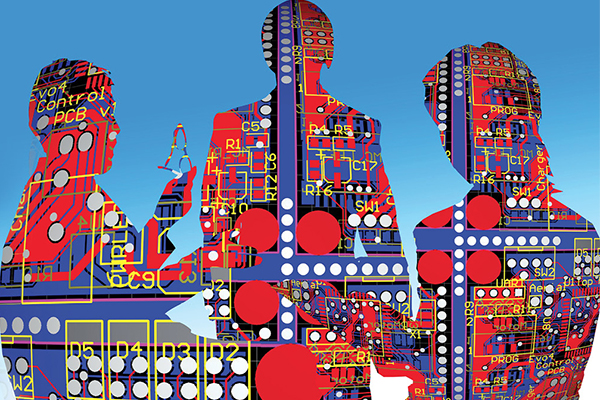 Editor’s Note: Frank Meerkamp is managing director and SCM expert at Accenture Applied Intelligence.
Editor’s Note: Frank Meerkamp is managing director and SCM expert at Accenture Applied Intelligence.
The traditional supply chain is a tapestry built on an outdated analog network – yet it exists in a digital world. This outdated supply chain model simply cannot effectively adhere to today's shifting market demands that stem from fluctuating geo-political landscapes and an increasingly connected and evolving global trade system. As such, organizations that rely on traditional supply chains are failing to optimize them in a holistic fashion.
To break free from the silos in which traditional supply chains operate in, as well as address evolving consumer expectations and overcome market volatility, organizations must adopt new, intelligent technologies—including AI and machine learning—with omni-channel solutions that can impact the bottom line, while maintaining the innovative and competitive advantage required to improve performance and deliver on customer experiences.
Evolving factors in the new digital market
In order for organizations to adopt intelligent solutions, it is first necessary to recognize the problems they face with traditional, fragmented supply chain models – the most immediate of which include:
- Market volatility adds uncertainty and risk – The shifting geopolitical landscape—including increasing regulations and sanctions, and unpredictability in price and supply—will continue to impact market factors, including regional competition. These fluctuations are testing companies' readiness to respond and their ability to operate efficiently on a global scale. Supply Chain Times, for instance, reported challenges faced as a result of Brexit: “In companies trading with the EU, the likely end of the free movement of goods will lead to a sharp increase in customs declarations for imports and exports. This entails considerable risks, including incorrect declarations and the threat of rapidly changing legal requirements.”
- Digital disruptors are owning the growth – In many categories, new niche brands are challenging legacy leaders by using digital technologies to provide more engaging and relevant experiences. For instance, Amazon, while enormous in scale, has successfully positioned itself as an innovator in groceries against traditional supermarkets, by acquiring Whole Foods and offering new services and decreased grocery charges for its existing Prime subscribers. Other legacy leaders are also trying to catch up by developing new competencies and capabilities.
- Consumer expectations are continually rising – Accenture's Global Consumer Shopping Survey showed that the newest generation of consumers are increasingly pivoting to retailers that provide the latest in digital marketing, especially social media. Customers want hyper-personalized experiences with customized products, and localized execution, including the ability to buy, collect and return anywhere, at any time. However, existing supply chains are not yet designed to fulfill one-of-a-kind customer requirements.
- Omni-channel engagement is difficult to deliver – Some legacy companies are trying to redesign their operations to provide a unified brand experience and frictionless fulfillment across all channels, but they are struggling to manage the execution while increasing profitability. Savvy organizations are utilizing monthly subscription-based models of delivery services to take advantage of centralized branding and improve customer convenience – Dollar Shave Club, Stitch Fix, and Blue Apron serve as leading examples of this trend.
These dynamics are exponentially increasing the complexity of the supply chain, which in turn is impacting both cost and risk for organizations. As a result, supply chains locked into traditional models are experiencing eroding margins and struggling to invest in new capabilities that will allow them to support new business models.
Data will fuel the visibility and agility of the supply chain
Organizations that establish a data-driven supply chain can gain advantages in increased forecasting accuracy, identifying and resolving issues in real time, creating new segmentations, and delivering on consumer requirements with speed, specificity and scale.
- Establishing exchange-to-exchange visibility and centralizing control – Intelligent technologies make it possible to manage supply chain complexity. Adoption can enable vast sets of structured and unstructured data to capture, process, and utilize to provide real-time visibility. Supply chain organizations leverage this power by creating “control towers” to centralize data and decision-making. Additionally, new network-based planners will help organizations drive internal, vendor and customer collaboration to align expectations, develop plans, and manage exceptions.
- Creating new performance engines – AI and machine learning enable powerful resolution engines, based on real-time root-cause analyses, to automate the execution of supply chain functions, and optimize transactions to meet strategic objectives. AI can process data in enormous quantities to perform real-time, what-if analyses and SCM modeling to optimize the supply chain along more variables than ever before. When a significant change occurs, the engine will determine the impact on key performance indicators (KPIs) and make immediate decisions that impact the supply chain and ultimately help the organization to achieve business outcomes and optimize financial results.
- Managing through agile decision-making – Leveraging the power of intelligent technologies, future management models can be fully collaborative, data-driven, and platform-based. Participants can share qualitative information and real-time data from the supply chain systems, review reports, and discuss implications on an ongoing basis. As exceptions are identified or opportunities arise, planners can create resolution options, share with stakeholders, discuss on the collaborative platform, and take immediate action.
- Developing a personalized and flexible approach – The computer power afforded from AI technology makes it possible to create more, and more-granular segmentation strategies that address consumers' personalized needs by channel, service level and locality. In addition, real-time visibility into market data will produce better insight, variation and urgency to enable greater understanding and meet demands. This empowers organizations to rapidly develop multiple supply chain models for a single, integrated network.
- Unifying and amplifying performance management – Advanced analytics provides a new way for organizations to measure and manage performance. In addition to tracking traditional functional metrics, supply chain organizations can determine impact on ultimate business outcomes. They can develop new end-to-end metrics to measure performance and cost across multiple functions, such as procure-to-pay and order-to-cash. Additionally, by using predictive scenario modeling, organizations can evaluate the business impact of various options, like corrective plans for missed supplier shipments or new promotional campaigns.
Ongoing optimization to achieve outcomes
Intelligent technology, including AI and machine learning enables goal to be attained over time through self-learning, predicting, prescribing and optimizing supply-chain performance automatically across business functions. Automation can flag and resolve exceptions in real-time and machine learning-based algorithms can predict these exceptions and supply chain outcomes. As the nature of the exception or resolution process changes over time, cognitive computing learns and adapts to it.
In turn, this enables supply chains to handle more complexity, making them more dynamic, flexible, adaptive and efficient. The result is a reinvented system that is more customer-centric, service-oriented, self-learning, and agile – with these innovations, businesses can ultimately improve their customer experiences and increase margins.
SC
MR


Latest Supply Chain News
- Survey reveals strategies for addressing supply chain, logistics labor shortages
- Israel, Ukraine aid package to increase pressure on aerospace and defense supply chains
- How CPG brands can deliver on supplier diversity promises
- How S&OP provides the answer to in-demand products
- AI, virtual reality is bringing experiential learning into the modern age
- More News
Latest Podcast

 Explore
Explore
Business Management News
- Survey reveals strategies for addressing supply chain, logistics labor shortages
- How CPG brands can deliver on supplier diversity promises
- How S&OP provides the answer to in-demand products
- AI, virtual reality is bringing experiential learning into the modern age
- Tips for CIOs to overcome technology talent acquisition troubles
- There is still work to do to achieve supply chain stability
- More Business Management
Latest Business Management Resources

Subscribe

Supply Chain Management Review delivers the best industry content.

Editors’ Picks





